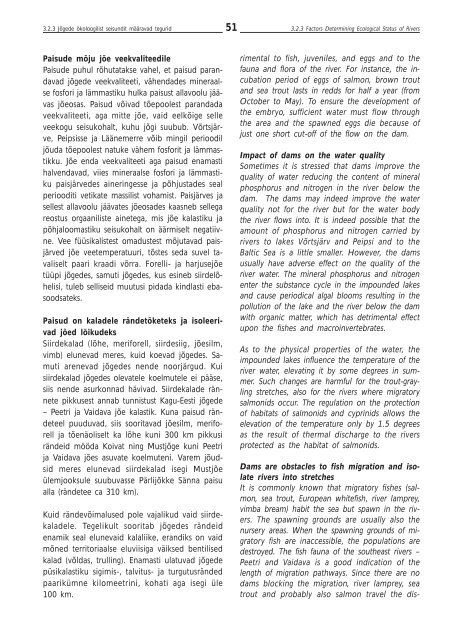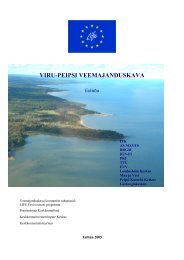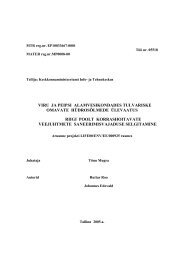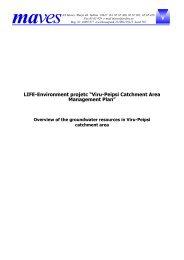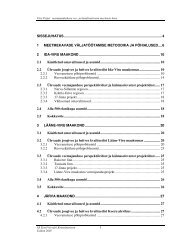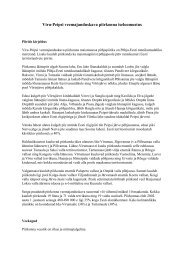Viru-Peipsi veemajanduskava - Keskkonnaministeerium
Viru-Peipsi veemajanduskava - Keskkonnaministeerium
Viru-Peipsi veemajanduskava - Keskkonnaministeerium
Create successful ePaper yourself
Turn your PDF publications into a flip-book with our unique Google optimized e-Paper software.
3.2.3 Jõgede ökoloogilist seisundit määravad tegurid<br />
51<br />
3.2.3 Factors Determining Ecological Status of Rivers<br />
Paisude mõju jõe veekvaliteedile<br />
Paisude puhul rõhutatakse vahel, et paisud parandavad<br />
jõgede veekvaliteeti, vähendades mineraalse<br />
fosfori ja lämmastiku hulka paisust allavoolu jäävas<br />
jõeosas. Paisud võivad tõepoolest parandada<br />
veekvaliteeti, aga mitte jõe, vaid eelkõige selle<br />
veekogu seisukohalt, kuhu jõgi suubub. Võrtsjärve,<br />
<strong>Peipsi</strong>sse ja Läänemerre võib mingil perioodil<br />
jõuda tõepoolest natuke vähem fosforit ja lämmastikku.<br />
Jõe enda veekvaliteeti aga paisud enamasti<br />
halvendavad, viies mineraalse fosfori ja lämmastiku<br />
paisjärvedes aineringesse ja põhjustades seal<br />
periooditi vetikate massilist vohamist. Paisjärves ja<br />
sellest allavoolu jäävates jõeosades kaasneb sellega<br />
reostus orgaaniliste ainetega, mis jõe kalastiku ja<br />
põhjaloomastiku seisukohalt on äärmiselt negatiivne.<br />
Vee füüsikalistest omadustest mõjutavad paisjärved<br />
jõe veetemperatuuri, tõstes seda suvel tavaliselt<br />
paari kraadi võrra. Forelli- ja harjusejõe<br />
tüüpi jõgedes, samuti jõgedes, kus esineb siirdelõhelisi,<br />
tuleb selliseid muutusi pidada kindlasti ebasoodsateks.<br />
Paisud on kaladele rändetõketeks ja isoleerivad<br />
jõed lõikudeks<br />
Siirdekalad (lõhe, meriforell, siirdesiig, jõesilm,<br />
vimb) elunevad meres, kuid koevad jõgedes. Samuti<br />
arenevad jõgedes nende noorjärgud. Kui<br />
siirdekalad jõgedes olevatele koelmutele ei pääse,<br />
siis nende asurkonnad hävivad. Siirdekalade rännete<br />
pikkusest annab tunnistust Kagu-Eesti jõgede<br />
– Peetri ja Vaidava jõe kalastik. Kuna paisud rändeteel<br />
puuduvad, siis sooritavad jõesilm, meriforell<br />
ja tõenäoliselt ka lõhe kuni 300 km pikkusi<br />
rändeid mööda Koivat ning Mustjõge kuni Peetri<br />
ja Vaidava jões asuvate koelmuteni. Varem jõudsid<br />
meres elunevad siirdekalad isegi Mustjõe<br />
ülemjooksule suubuvasse Pärlijõkke Sänna paisu<br />
alla (rändetee ca 310 km).<br />
Kuid rändevõimalused pole vajalikud vaid siirdekaladele.<br />
Tegelikult sooritab jõgedes rändeid<br />
enamik seal elunevaid kalaliike, erandiks on vaid<br />
mõned territoriaalse eluviisiga väiksed bentilised<br />
kalad (võldas, trulling). Enamasti ulatuvad jõgede<br />
püsikalastiku sigimis-, talvitus- ja turgutusränded<br />
paarikümne kilomeetrini, kohati aga isegi üle<br />
100 km.<br />
rimental to fish, juveniles, and eggs and to the<br />
fauna and flora of the river. For instance, the incubation<br />
period of eggs of salmon, brown trout<br />
and sea trout lasts in redds for half a year (from<br />
October to May). To ensure the development of<br />
the embryo, sufficient water must flow through<br />
the area and the spawned eggs die because of<br />
just one short cut-off of the flow on the dam.<br />
Impact of dams on the water quality<br />
Sometimes it is stressed that dams improve the<br />
quality of water reducing the content of mineral<br />
phosphorus and nitrogen in the river below the<br />
dam. The dams may indeed improve the water<br />
quality not for the river but for the water body<br />
the river flows into. It is indeed possible that the<br />
amount of phosphorus and nitrogen carried by<br />
rivers to lakes Võrtsjärv and <strong>Peipsi</strong> and to the<br />
Baltic Sea is a little smaller. However, the dams<br />
usually have adverse effect on the quality of the<br />
river water. The mineral phosphorus and nitrogen<br />
enter the substance cycle in the impounded lakes<br />
and cause periodical algal blooms resulting in the<br />
pollution of the lake and the river below the dam<br />
with organic matter, which has detrimental effect<br />
upon the fishes and macroinvertebrates.<br />
As to the physical properties of the water, the<br />
impounded lakes influence the temperature of the<br />
river water, elevating it by some degrees in summer.<br />
Such changes are harmful for the trout-grayling<br />
stretches, also for the rivers where migratory<br />
salmonids occur. The regulation on the protection<br />
of habitats of salmonids and cyprinids allows the<br />
elevation of the temperature only by 1.5 degrees<br />
as the result of thermal discharge to the rivers<br />
protected as the habitat of salmonids.<br />
Dams are obstacles to fish migration and isolate<br />
rivers into stretches<br />
It is commonly known that migratory fishes (salmon,<br />
sea trout, European whitefish, river lamprey,<br />
vimba bream) habit the sea but spawn in the rivers.<br />
The spawning grounds are usually also the<br />
nursery areas. When the spawning grounds of migratory<br />
fish are inaccessible, the populations are<br />
destroyed. The fish fauna of the southeast rivers –<br />
Peetri and Vaidava is a good indication of the<br />
length of migration pathways. Since there are no<br />
dams blocking the migration, river lamprey, sea<br />
trout and probably also salmon travel the dis-


